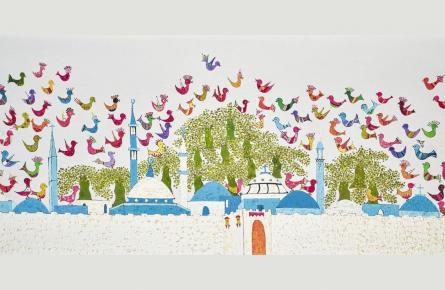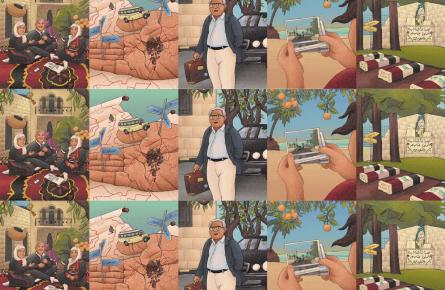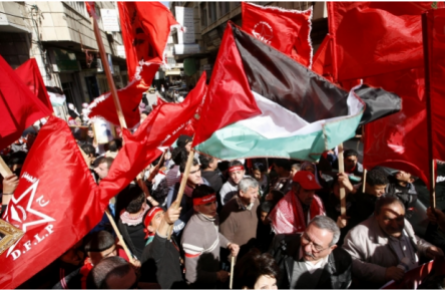One of the many ways settler-colonialism imposes power is by controlling the colonized people’s perception of reality, constraining them to believe that the current status quo is permanent and imagining beyond such a state is impossible. This is exactly what Israel is doing to Palestinians in and outside of Palestine.
Israel strives to prevent Palestinians from having hope or being joyful. Whether they are assaulting marathon runners, like those met with stun grenades and rubber coated bullets while running through the embattled neighborhoods of Sheikh Jarrah and Silwan in Jerusalem, confiscating kites, or spraying over art, Israelis consistently try to crush the Palestinian spirit. Palestinians also face censorship attempts offline on campuses and workplaces and online by Instagram and Facebook. But no matter how many times Israel tries, the Palestinian mind cannot be occupied.
Palestinians have radically imagined a liberated Palestine through poetry, like that of Harun Hashim Rashid, storytelling, featured in Palestine +100, community conversations, like those held on ClubHouse, or social media, as recently seen with the trending Twitter hashtag #Tweet_Like_It’s_Free… it being Palestine.
In an interview with Palestine Square, three young Palestinian women living in the Middle East and North African diaspora shared their perceptions of a liberated Palestine.
Images of a Free Palestine
Amina
Amina Ali, 21, is a graduating senior at the American University of Beirut. Ali spoke to Palestine Square via Zoom, all the way from Jadra, a coastal village that is only seven minutes’ drive from Saida, Lebanon. She spoke about the village she comes from in Palestine called Suhmata.
“[It’s] located in the district of Akka,” Ali said, with a smile on her face. “It's actually a 30 minute drive from the Lebanese border, which is so sad. I've never been [there] because I've [lived] in Lebanon all my life.”
Ali’s village, Suhmata, was one of many villages that were ethnically cleansed during the Nakba in 1948.
The wall behind Ali was draped with photos and posters from and about Palestine. She described that wall as her sanctuary. One poster was the map of Palestine with the words “Returning to Haifa” on top, referencing Ghassan Kanafani’s renowned novel of the same title.
Prior to taking the call with this writer, Ali was listening to a love song called Le’Bnaya (the daughter) by Palestinian music producer Marwan Asad.
“I wonder [what] it would be like if my children got married in Palestine,” she pondered. “How would Suhmata look? Would I be there? Would I have an apartment somewhere? Would I be living in the city? Would I be living in the village?”
Yet even in this radical imagination of a liberated Palestine, Ali kept in mind the deep societal issues the Palestinian community faces. “I want to imagine a Palestine that isn’t necessarily free of all these problems, but is actively working [to resolve them].”
Ali also touched on the importance of collective Palestinian imagination, despite the scatteredness of its diaspora.
“The fact that we grew up in different places that are not Palestine, even [within] the same country we grew up in different places, [but that] doesn't mean that we can't imagine something together,” Ali said.
Ali made an effort to picture herself in her ancestral homeland, but she still found the act of materializing what could exist challenging.
“Maybe we don’t allow ourselves as Palestinians to dream [as much] because we are scared, we were disappointed too many times.”
Noura
Noura Al-Shanti, 20, also comes from the now-demolished villages of al-Jiyya and Bir el-Sabe’. While her father spent most of his teenage years in Gaza, she grew up in Cairo.
While she carries a Palestinian travel document and was able to visit Gaza, she has never been to her ancestral home in the villages.
“All I know [about al-Jiyya and Bir el-Sabe'] is what I know from my grandparents, like how green it was, how people used to live, how life was simpler back then,” Al-Shanti said. “I can imagine what they're saying, I feel like I've built my own Palestine in my head.”
Al-Shanti said that her grandparents viewed their refuge in Gaza and Egypt as temporary.
“When [my grandfather] was on his deathbed, I remember him saying: I lived my entire life saying it will just be two months, three months, a year and then my age passed me, and I've never been back home,’” Al-Shanti’s voice cracked. “That was [so] heart-breaking. I was like, where is home Jedo? You know, where is home?
Al-Shanti’s ancestral home in al-Jiyya was large enough to fit her growing family.
“[I imagine] we'd always have breakfast together. Our house is by the sea. We'd have zaatar, olives, tea with sage on our table all the time”
The state of temporary living is common among Palestinians in exile. .
Farah
Farah Ali, 19, is a resident in Doha, Qatar. She imagines that a liberated Palestine will rid Palestinians of all things temporary.
“I imagine something permanent,” Farah said, fiddling with her silver Palestinian map necklace.
Farah’s grandparents became internally displaced in Palestine after the Nakba. Struggling to survive, they sought work opportunities in Kuwait. Both of her parents were born in Kuwait, but after the Iraqi invasion, they were among the Palestinians exiled again. They moved to Jordan, lived shortly in the United States, then moved back to the Gulf and settled in Qatar.
The wall behind Farah was also decorated with a poster with the words “Returning to Haifa.” Farah’s family, however, hails from Tulkarem, from the neighborhood of Shwayka.
“I've never visited Palestine and my parents have never visited.”
“I know that there were like seven families living there. And even though my dad has never been to Palestine, he always tells me about the houses [in the village]… [and how] the villagers were reliant on olive oil and fig trees.”
Yet, despite listening to all the stories from their grandparents and parents growing up, all three, Amina Ali, Noura Al-Shanti, and Farah Ali, described finding difficulties in imagining a liberated Palestine.
Radical Imagination Under Settler-Colonialism
Yara Hawari, a Senior Analyst at Al-Shabaka, wrote about Palestinians’ radical imagination of the future against the constraints of colonialism
“Settler colonial and colonial projects... seek to control perceptions of reality in order to bind Indigenous and colonized people in a seemingly perpetual state of being, or normalized stasis. Imagining a future beyond this state is thus a rebellious and radical act, and is by no means an easy one.”
In an interview with Palestine Square, Hawari said that imagination to liberate Palestine is difficult by design.
“I don't think [that] it's Palestinians lacking that creative ability, it’s been designed so Palestinians can’t even begin to imagine that [possibility].” Hawari said via Zoom.
She said that such difficulties of imagining the future stem from a deeper cause.
“[For] Palestinians who've never been to Palestine, never lived in Palestine - so the refugees and those in the diaspora - I think it can be incredibly difficult to imagine a liberated something when you've never seen that something or been to that something. That's very understandable,” Hawari noted. “The fact that they [remain] in exile, they lose connection [to] Palestine - that is deliberate policy that Israel enacts.”
Hawari added that radical imagination can be considered a form of resistance.
“In essence, radical imagination can be resistance because it is rejecting colonial permanence, it is rejecting colonial notions of time, of reality.”
In her Al Shabaka commentary, Hawari also talks about the importance of Palestinians imagining. She cites examples like the group Decolonizing Architecture Art Residency (DAAR) in Bethlehem. She writes that, due to the fragmentation of Palestinian society, “the struggle is therefore not only to imagine, but to do so collectively.”
“The collective is very important, especially in the case of Palestine,” Hawari added on the call. “I encourage both individuals and collective radical imagination. But when it becomes collective, that's when things are taken up a notch, when you [go] beyond just one person dreaming of a free Palestine. When it's done collectively, it certainly becomes more serious.”
Imagining Hope
Despite the horrific violence and attacks Gaza and Jerusalem faced (and continue to face), the uprisings and resistance that Palestinians have displayed, from the occupied territories of 1948, to the West Bank, to the besieged Strip, to the rest of the world, have restored hope that Palestinians will see a liberated Palestine.
Palestinians all over the world, collectively, began to imagine a free Palestine within their lifetime. As the people of Gaza and elsewhere celebrated the ceasefire, Palestinians imagined what celebrations would look like once Palestine is liberated.
The recent acts of demonstrations and the gradual unification of Palestinians in historic Palestine and abroad have progressively begun extinguishing Israel’s control over their perception of time and reality. Palestinians are no longer confined to believe that the current reality has to be permanent. Palestinians are powerfully and radically imagining a nearby future of a free Palestine, a Palestine to which Amina, Noura, and Farah will be able to return.




